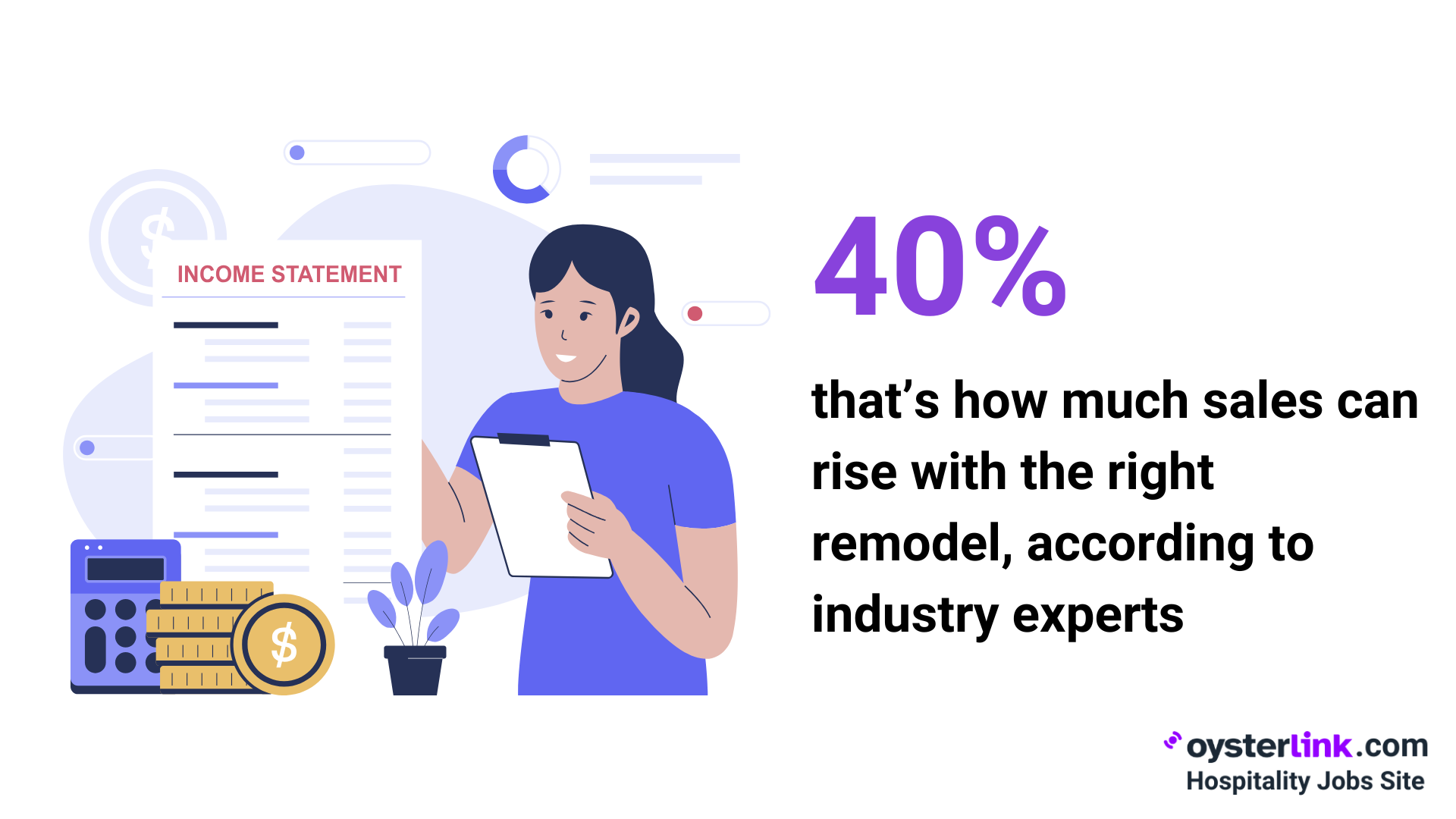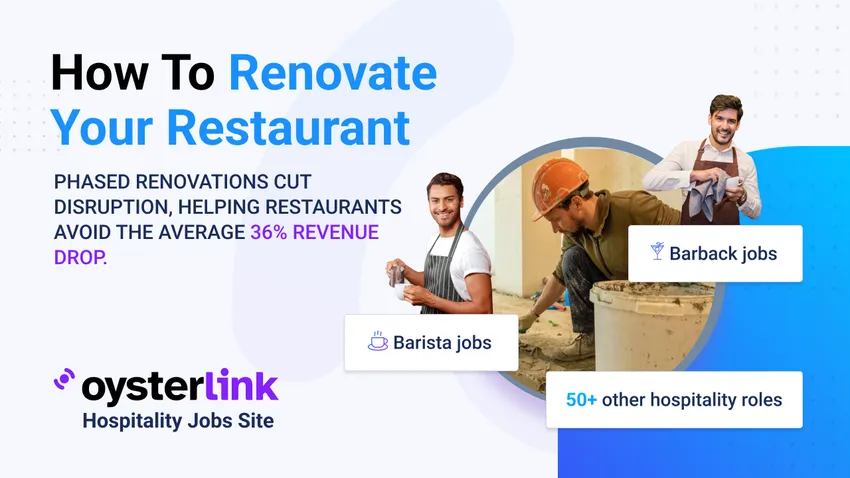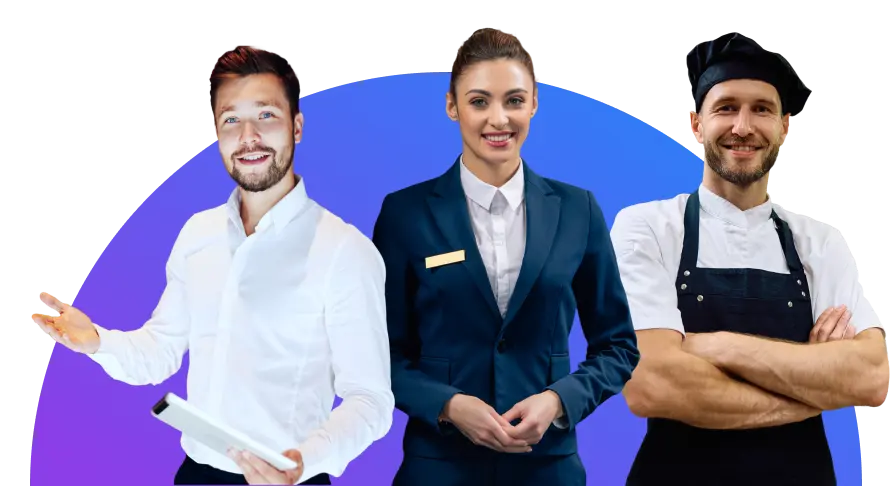Below, we break down how to renovate your restaurant in phases, manage costs and maximize your revenue — all while minimizing the headaches.
Why You Should Renovate Restaurant Spaces in Phases vs. Full Closure
Restaurant closures are devastating for business continuity.
Studies show that 87% of full-service restaurants experience an average 36% drop in sales revenue during major disruptions.
And with typical profit margins of just 5-6%, even short closures can be fatal.

How To Renovate Restaurant Operations Successfully
Assess and prioritize renovation needs
Begin by walking through your restaurant to spot what needs the most urgent attention.
Group any critical repairs — like a leaking walk-in fridge or broken tiles in the entrance — alongside any aesthetic improvements planned down the road.
Tackle safety issues and kitchen bottlenecks early to prevent bigger problems later.
Bring in team leads and maybe a couple of regulars for perspective. Sometimes the regulars have a sharper eye than you'd expect!
Create a detailed renovation plan and timeline
Divide renovations into sensible phases based on your restaurant's layout and workflow.
Assign estimates for how long each phase will take and align them with your slowest days or hours.
Proper planning helps avoid confusion and keeps service interruptions to a minimum.
Obtain permits and communicate with local authorities
Before picking up any tools, be sure you have the proper permits in hand and set up inspections as required.
It's easier to keep things on track (and avoid fines) with a good relationship with city officials and inspectors.
Schedule work during off-hours or downtime
Whenever possible, schedule the noisiest tasks when customers aren't around — think early mornings or after close.
Even a few hours midweek can make a difference, especially if you warn staff ahead of time.
Be sure to avoid Fridays for any major disruptions.
It's typically the busiest day of the week, and you'll want all hands on deck to deliver a smooth, high-energy guest experience.
.png)
Renovate one area at a time
Focusing on only one space per phase — be it the kitchen, dining room or bathrooms — means you can keep the rest of your operation humming along.
This keeps your regulars coming back and your registers ringing, even with some minor inconvenience.
If you haven't already, consult resources on hiring reliable kitchen staff to ensure you don't get bottlenecked when areas shift through renovation.
Redesign temporary service flows
When part of your operation is under construction, get creative.
Adjust guest entry points, rework the seating arrangement or temporarily embrace a pop-up patio.
Customers will appreciate the extra effort — and might even enjoy the change of scene.
You could also hand out a free coffee or dessert to returning guests during the more chaotic weeks — it's a small gesture but it goes a long way.
Communicate with staff and customers
Keep your people in the loop, share regular updates, train staff on temporary changes and make sure guests understand what's happening.
Face-to-face conversations, quick digital updates and simple in-store signs work best.
Action steps:
- Set up a private Slack or group chat for staff to ask questions and get quick updates.
- Print and post "pardon our dust" signs at all entrances and refresh them as work moves from room to room.
- Run a short Q&A at each pre-shift meeting for renovation updates — sometimes you'll hear great suggestions you hadn't considered.
Monitor progress and adjust as needed
Regular check-ins with contractors and your staff will help you catch issues early.
It's important to listen — sometimes a small tweak keeps things moving, or staff spot a shortcut that saves hours down the line.
For example, jot wins on an office whiteboard, so everyone sees progress — and reward employees with coffee or lunch on the house.
For more on building a resilient restaurant career, check out industry insights from those who've managed big transitions.
.png)
How To Renovate Restaurant Budgets While Staying Open
Set realistic budgets by phase
Break your overall spend into chunks for each renovation phase.
Always add buffer for surprises — it's better to have leftover funds than scramble at the finish.
Use Google Sheets to log each phase's estimate, actuals, payments and running totals.
Negotiate with contractors for flexible schedules
When hiring, ask if crews can work off-hours and structure payments by milestone.
Some contractors are more flexible — don't be afraid to compare bids or ask for references who've survived a phased renovation.
Get 2-3 bids per major phase. Ask if the contractor can pause or shift schedules if things run late, especially after surprise delays.
Leverage revenue from ongoing operations
Staying open means you keep money coming in, which eases budget stress.
Funnel those earnings into each phase bit by bit rather than taking on more debt or tying up credit lines.
If possible, line up renovations for your slowest revenue periods and run "thank you" specials or happy hours to keep guests interested.
For additional inspiration, these tips to fix your restaurant's money problems can help keep your financials in check as you go.
Benefits When You Renovate Restaurant Facilities in Phases
Reduced business disruption
Broken into stages, a renovation won't chase regulars away.
Instead, people return for their favorite dishes and get to see (and talk about) the progress as it happens.
Continuous revenue stream
Industry experts recommend a renovation every 5 to 10 years, with strategic remodeling potentially boosting sales by up to 40%.
Phased renovations allow you to tap into these gains without putting your entire operation on hold.

Ongoing staff employment
Staying open lets you keep your team working.
You avoid the morale hit and turnover costs of layoffs — and when it's all done, you don't have to retrain a whole new crew.
If you ever need to refine your Restaurant Manager role to encourage staff retention, now is a great time to review and make clarifications.
Tips To Maximize Revenue When You Renovate Restaurant Facilities
Offer specials and promotions
Give customers a reason to visit with timely promotions — "pardon our dust" specials, loyalty perk days or sneak peeks keep guests chatting about you for the right reasons.
For example, host a "Renovation Happy Hour" or "Future's So Bright" event — locals love an inside look and will often share pics on social media.
Check out this advice on finding the best staff for your restaurant to run these events more smoothly.
Emphasize takeout/delivery options
Social media is not just growing, it's exploding. The chart below shows how usage has surged in recent years and is still climbing.
If you’ve lost seating, don’t just wait it out — pivot smart. Use that attention online to drive revenue off-premise.
Drop a takeout code like “Kitchen’s Hot, Dining Room’s Closed” or create crave-worthy bundles just for delivery.
People are scrolling to be fed — with ideas, comfort, and meals. Meet them there.
A single well-timed post can turn someone who’s never walked through your doors into a loyal customer at home.
Use social media to share updates
Don’t just announce the dust — invite people into the journey.
Share honest updates, behind-the-scenes clips, and moments that show the heart behind the hammer.
A video of the owner opening up about the renovation (especially if it’s tied to family, passion) will land deeper than any polished promo.









Loading comments...